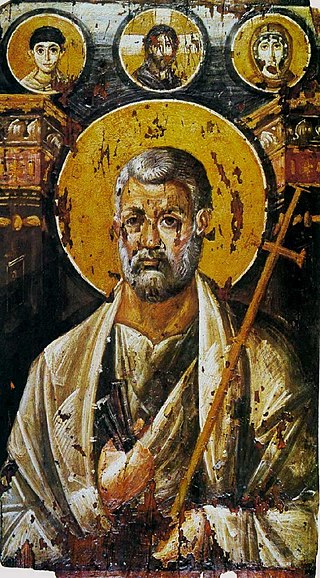
Encaustic painting, also known as hot wax painting, is a form of painting that involves a heated wax medium to which colored pigments have been added. The molten mix is applied to a surface—usually prepared wood, though canvas and other materials are sometimes used. The simplest encaustic medium could be made by adding pigments to wax, though recipes most commonly consist of beeswax and damar resin, potentially with other ingredients. For pigmentation, dried powdered pigments can be used, though some artists use pigmented wax, inks, oil paints or other forms of pigmentation.

World Expo 88, also known as Expo 88, was a specialised Expo held in Brisbane, the state capital of Queensland, Australia, during a six-month period between Saturday, 30 April 1988 and Sunday, 30 October 1988, inclusive. The theme of the Expo was "Leisure in the Age of Technology", and the mascot for the Expo was an Australian platypus named Expo Oz.

Gidon Kremer is a Latvian classical violinist, artistic director, and founder of Kremerata Baltica.
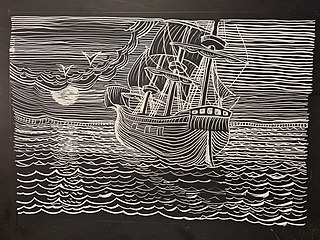
Scratchboard or scraperboard, is a form of direct engraving where the artist scratches off dark ink to reveal a white or colored layer beneath. Scratchboard refers to both a fine-art medium, and an illustrative technique using sharp knives and tools for engraving into a thin layer of white China clay that is coated with dark, often black India ink. There is also foil paper covered with black ink that, when scratched, exposes the shiny surface beneath. Scratchboard can be used to yield highly detailed, precise and evenly textured artwork. Works can be left black and white, or colored.

Walter Ufer was an American artist based in Taos, New Mexico. His most notable work focuses on scenes of Native American life, particularly of the Pueblo Indians.
Thomas Aquinas Daly is an American contemporary landscape and still life painter.
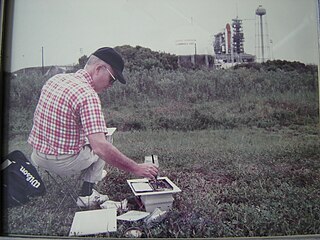
Philip Jamison was an American artist working primarily with watercolor as a medium. Typical scenes are landscapes, seascapes, interiors and flower arrangements.

Robert Beverly Hale was an artist, curator of American paintings at the Metropolitan Museum of Art, and instructor of artistic anatomy at the Art Students League of New York and the Pennsylvania Academy of Fine Art. He was also the author of the well-known book Drawing Lessons from the Great Masters, as well as the translator of the classic anatomy text Artistic Anatomy by Dr. Paul Richer.

Classical Realism is an artistic movement in the late-20th and early 21st century in which drawing and painting place a high value upon skill and beauty, combining elements of 19th-century neoclassicism and realism.
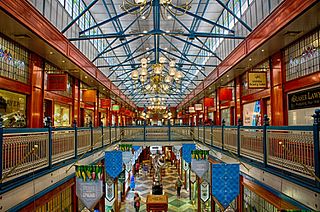
Brisbane Arcade is a heritage-listed shopping arcade at 160 Queen Street through to Adelaide Street in the Brisbane CBD, City of Brisbane, Queensland, Australia. It was designed by Richard Gailey, Junior and built in 1923 to 1924 by J & E L Rees and Forsyth & Speering. It was added to the Queensland Heritage Register on 21 October 1992.

Floyd MacMillan Davis was an American painter and illustrator known for his work in advertising and illustration; Walter and Roger Reed described him as "someone who could capture the rich, beautiful people of the 1920s: dashing, mustachioed men; the cool, svelte women. But Davis was just as capable at capturing just-plain-folk, and with a cartoonist's sensibilities and a fresh humor, he expanded into story art and ad work that called characters of every persuasion.
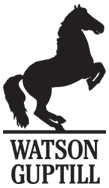
Watson-Guptill is an American publisher of instructional books in the arts.
Ingres paper is a type of drawing paper. It is a laid finish paper of light to medium weight, and it is not as strong or as durable as Bristol paper. Laid finish refers to the imprint of regular screen pattern of a papermaker's mould. Ingres is not necessarily a handmade paper, but is produced to replicate the properties of laid paper. Ingres is often used for charcoal and pastel drawing. It is also used as an endpaper in books.
Jan V. White (1928-2014) was an American designer, communication design consultant, and graphic design educator and writer.

A flyer is a form of paper advertisement intended for wide distribution and typically posted or distributed in a public place, handed out to individuals or sent through the mail. In the 2010s, flyers range from inexpensively photocopied leaflets to expensive, glossy, full-color circulars. There are also digital flyers, similar to the printed ones, but can be shared on the internet.

Judy Watson is an Australian Waanyi multi-media artist who works in print-making, painting, video and installation. Her work often examines Indigenous Australian histories, and she has received a number of high profile commissions for public spaces.
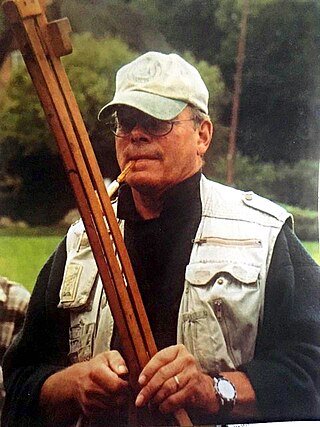
Charles Clark Reid was an American painter, illustrator, and teacher, notable for his watercolor style. He won numerous national and international awards for both his watercolor and oil works, and also hosted many workshops in the US and abroad. He published numerous books and instructional DVDs and created a postage stamp and an iconic ad campaign with his watercolor depictions. His watercolor works and oil paintings are in private and college museum collections.

Friedrich Graetz or Grätz was an Austrian illustrator and cartoonist. His best-known works appeared in Viennese satirical magazines such as Kikeriki and Der Floh, and in the American magazine Puck. Puck was the first magazine to print cartoons in color. Many of Graetz's cartoons were political, targeting issues of government responsibility and public health and urging social change.
Edward Howard Betts was an American painter, collagist, author, and teacher. He was known for his abstract paintings which he developed using an improvisational method. He was also an accomplished painter of realistic watercolors. Betts published three instructional books on painting and taught at the University of Illinois.















